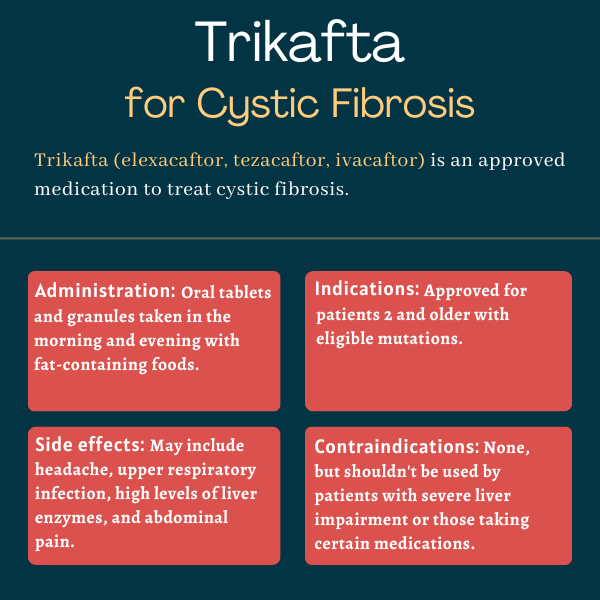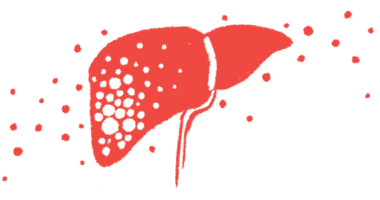Trikafta (elexacaftor/tezacaftor/ivacaftor) for cystic fibrosis
What is Trikafta for CF?
Trikafta is a combination of three cystic fibrosis (CF) oral medications: elexacaftor, tezacaftor, and ivacaftor.
Developed by Vertex Pharmaceuticals, Trikafta became the first triple therapy approved for CF.
Therapy Snapshot
| Brand Name: | Trikafta |
| Chemical Name: | elexacaftor/tezacaftor/ivacaftor |
| Usage: | Triple combination CFTR modulator |
| Administration: | Oral tablets and granules |
How does Trikafta work?
A genetic disease, CF is caused by mutations in the CFTR gene. This gene provides the instructions necessary for cells to make the CFTR protein, which is a transporter that controls the movement of charged ions across cell membranes.
Mutations in CFTR mean that salts cannot cross cell membranes normally. This leads to the buildup of thick, sticky mucus in different tissues and organs, especially the lungs and the digestive tract. In the lungs, this mucus can interfere with breathing, and make patients more susceptible to respiratory infections.
While more than 2,000 mutations have been identified in the CFTR gene, the F508del mutation is the most common CF-causing genetic defect. It is seen in about 90% of all people with the disease.
This mutation results in a premature stop signal in the genetic code, causing cells to make a truncated or shorter-than-normal CFTR protein. The cells cannot shuttle this truncated protein to the surface as efficiently as normal CFTR, resulting in abnormal ion transport.
Trikafta is a CFTR modulator that helps defective CFTR proteins work more effectively. Both elexacaftor and tezacaftor work as correctors. They bind to the faulty CFTR protein and help it fold correctly. This way, cells can shuttle more of it to the membrane instead of degrading the newly formed protein. Ivacaftor — also marketed independently as Kalydeco — is a potentiator: it binds to the CFTR protein and holds the channel open so that more salt can pass through it.
With a combination of all three therapies, more active and functional CFTR proteins reach the cell membrane.
Who can use Trikafta?
Trikafta has been approved in more than 30 countries, including the U.S., Canada, and Australia. It is widely available in Europe.
The treatment was approved by the U.S. Food and Drug Administration (FDA) in October 2019 to treat CF patients, ages 12 and older, with at least one F508del mutation. The FDA expanded the number of eligible mutations for Trikafta in December 2020.
The therapy’s approval was once again expanded in 2021 by the FDA, to cover children as young as 6, and in 2023 for children as young as 2 years old. Most recently, the FDA again expanded the number of mutations eligible for Trikafta treatment.
Before Trikafta’s FDA approval, Kalydeco was approved in 2012, while Orkambi — which contains lumacaftor and ivacaftor — received approval in 2015. In addition, the combination of tezacaftor and ivacaftor, called Symdeko (marketed as Symkevi in the EU) was approved in 2018.
Health Canada approved the therapy in 2021 for people ages 12 and older who have at least one copy of the F508del mutation. The Canadian regulatory agency recently also expanded the therapy’s approval to cover children as young as 6.
In the EU, the European Commission (EC) approved the Vertex triple combo — marketed in those countries under the brand name Kaftrio — in combination with Kalydeco in 2020 for patients with two F508del mutations or one F508del and one minimal function mutation, or a mutation in which the resulting CFTR protein works minimally. The EC in 2021 also expanded the list of approved secondary mutations that can be treated with the triple combination.
More recently, the EC expanded the use of Kaftrio to children as young as 2. A similar decision was made in the U.K.
Who should not use Trikafta?
There are no contraindications for Trikafta. However, the treatment’s FDA label features a boxed warning noting Trikafta can cause serious and life-threatening liver injury and liver failure.
Trikafta should not be used in individuals who have severe liver impairment. In patients with moderate liver impairment, the therapy is not recommended and should be used only if there’s a clear medical need and the benefits outweigh the risks.
How is Trikafta administered?
Trikafta granules are supplied in morning and evening unit-dose packets. Granules are white to off-white, sweetened and unflavored.
For children ages 2-5 and weighing less than 14 kg (30.9 lbs.), morning packets are white and blue, whereas evening packets are white and green. For children of the same age range who weigh more, morning packets are white and orange; evening packets are white and pink.
Trikafta tablets are available in blister cards for a four-week period. Each card contains 21 tablets: orange tablets are to be taken in the morning and blue tablets in the evening.
Tablets and granules should be taken with fat-containing food to help with absorption. Fat-containing foods include butter, peanut butter, eggs, meat, nuts, and whole-milk dairy products. Foods and drinks containing grapefruit should be avoided.
For children ages 2-5 and weighing less than 14 kg, the recommended dose is:
- One white and blue packet containing elexacaftor 80 mg, tezacaftor 40 mg, and ivacaftor 60 mg oral granules
- One white and green packet containing ivacaftor 59.5 mg oral granules.
- One white and orange packet containing elexacaftor 100 mg, tezacaftor 50 mg, and ivacaftor 75 mg oral granules
- One white and pink packet containing ivacaftor 75 mg oral granules.
For children ages 6-11 and weighing less than 30 kg (66 lbs.), the recommended dose is:
- two light orange tablets, sized 12 mm by 6 mm, debossed with “T50” on one side and plain on the other, containing 50 mg of elexacaftor, 25 mg of tezacaftor, and 37.5 mg of ivacaftor
- one light blue capsule-shaped tablet, sized 13 mm by 7 mm, printed with “V75” in black ink on one side and plain on the other, containing 75 mg of ivacaftor.
For children ages 6-11 weighing 30 kg (66 lbs.) or more, and people ages 12 years and older, the recommended dose is:
- two orange capsule-shaped tablets, sized 16 mm by 8 mm, debossed with “T100” on one side and plain on the other, containing 100 mg of elexacaftor, 50 mg, and 75 mg of ivacaftor
- one light blue capsule-shaped tablet, sized 17 mm by 8 mm, printed with “V 150” in black ink on one side and plain on the other, containing 150 mg of ivacaftor.

Trikafta in clinical trials
The FDA approved Trikafta based on the results of two Phase 3 clinical trials: AURORA F/MF (NCT03525444) and AURORA F/F (NCT03525548).
Patients ages 12 and older
The AURORA F/MF trial enrolled 403 individuals with CF, ages 12 and older, with one F508del mutation (F) and one minimal function mutation (MF). The study tested the effect of Trikafta against a placebo for 24 weeks, or about six months.
In the AURORA F/F trial, 107 patients with two F508del mutations (F/F) received Symdeko for the first four weeks, or about one month. Then, participants were randomly split into two groups for four more weeks of treatment: one group switched to Trikafta and the other group was maintained on Symdeko.
The primary outcome or goal of both trials was the change in percent predicted forced expiratory volume in one second (ppFEV1), a measure of lung function. Secondary measures included the number of pulmonary exacerbations, levels of sweat chloride — a way to assess CFTR function — and change in the CF Questionnaire Revised respiratory domain score, which assesses respiratory symptoms relevant to people with CF.
Data from both studies showed significant improvements in lung function in Trikafta-treated patients, with ppFEV1 improving by an average of 14.3% in AURORA F/MF, and by 10% in those in AURORA F/F. Patients generally tolerated the treatment well.
In the first trial, the number of pulmonary exacerbations was significantly reduced by 63% in patients taking Trikafta compared with those on placebo. A significant decrease in sweat chloride and CF respiratory symptom score also was also observed in both trials.
Participants in both trials had the option to continue in an open-label extension study (NCT03525574), in which all were treated with Trikafta and followed for long-term safety and efficacy outcomes. At nearly three years of treatment, results showed stable improvements in lung function, respiratory symptoms, sweat chloride levels, and nutritional status among both adults and adolescents with CF.
Children ages 6 to 11
Vertex also unveiled positive results from another Phase 3 trial (NCT03691779), which evaluated the safety, tolerability, and efficacy of Trikafta in children ages 6 to 11. That study investigated the therapy’s pharmacokinetics, or its movement into, through, and out of the body, and its pharmacodynamics, which are its effect on the body. This open-label study recruited 66 children with either F/F or F/MF mutations for 24 weeks of treatment. All patients were treated with Trikafta and assessed before and after the treatment.
This study found that children tolerated Trikafta well. When compared with the pretreatment results, patients showed improvements in ppFEV1, by 10.2 percentage points, and sweat chloride. The CF Questionnaire-Revised respiratory domain score increased by seven points and the lung clearance index (a measure of lung ventilation) had a reduction of approximately two points.
Children ages 2 to 5
The FDA label extension to cover ages 2 to 5 was based on the results of a Phase 3 clinical trial (NCT04537793) in children among this age range with at least one F508del mutation in CFTR. This study showed that Trikafta was generally well tolerated, with similar safety to what was observed in older age groups. It was also effective in reducing sweat chloride concentration. Body mass index, a measure of body fat, remained stable throughout the 24 weeks of treatment.
PROMISE trial
An observational study called PROMISE (NCT04038047) has enrolled 490 CF patients, 12 years and older, to assess the long-term impact of Trikafta on pulmonary function, sweat chloride, body weight and overall health over two years of treatment.
Preliminary results from this study showed that long-term treatment with Trikafta significantly increased daily calorie intake and also led to a reduction in energy expenditure. This is particularly important for most CF patients as malnutrition is common in this patient population.
Ongoing trials
PROMISE pediatric trial
The long-term effect of Trikafta on those CF-related manifestations also is being assessed in children in the PROMISE pediatric study (NCT04613128). This two-year trial, running at multiple sites in the U.S., has enrolled about 180 children, ages 6 to 11. The study is expected to conclude in December 2025.
BEGIN trial
The BEGIN study (NCT04509050) is being conducted at 34 sites across the U.S. and involves about 210 CF children up to age 10. It aims to evaluate the effect of Trikafta on several health parameters, such as gastrointestinal, lung, liver, and pancreatic functions, as well as sweat chloride, inflammation, and bone health. Other factors include gut and respiratory bacteria, as well as growth and height. The study is expected to end in December 2029.
Common side effects of Trikafta
Common side effects of Trikafta include:
- headache
- upper respiratory infection
- common cold
- nasal congestion
- runny nose
- flu
- rash
- high levels of liver enzymes
- elevated levels of creatine phosphokinase (a marker of muscle damage)
- abdominal pain
- diarrhea.
Liver damage
Trikafta contains a boxed warning noting the risk of drug-induced liver injury and liver failure. Cases of liver failure resulting in transplant or death, and of liver injury up to 15 months following initiation of Trikafta have been reported.
Tests of liver function should be performed prior to starting on Trikafta, monthly for the first six months of treatment, every three months for the next year, and at least annually after that. More frequent monitoring may be needed in individuals who show signs of liver abnormalities or who have a history of liver disease.
Trikafta should be interrupted if patients show signs of liver damage on lab tests or symptoms indicative of liver injury, such as jaundice (yellowing of the skin and eyes), pain in the upper right part of the abdomen, nausea, vomiting, or altered mental status. Patients should be monitored closely until signs of liver damage resolve, and if they do, patients may restart on Trikafta with careful monitoring of liver function.
Trikafta should not be used in patients with severe liver impairment. In individuals with moderate liver impairment, it may be used if the benefits clearly outweigh the risks, but close monitoring is needed.
Eye problems
Cases of cataracts — a clouding of the eye lens — have been observed in children treated with ivacaftor-containing therapies. Eye assessments at the beginning of the study and during follow-up are recommended in children who start the treatment with Trikafta.
Dizziness
Trikafta may cause dizziness in some people. As such, patients should not drive a car, use machinery, or do any task that needs them to be alert until they know if they experience this issue.
Use with other medications
Trikafta may affect the way other medications work, and vice versa. Therefore, patients should not take Trikafta when using antibiotics such as rifampin and rifabutin, seizure treatments, and St. John’s wort.
Patients treated with strong or moderate CYP3A inhibitors should use a reduced dose of Trikafta.
Use in pregnancy and breastfeeding
Animal studies have been conducted on each of Trikafta’s active components. The results generally did not show treatment-related adverse effects on fetuses or on offspring development, with the exception of decreased fetal body weights and early developmental delays (found with tezacaftor). However, there are limited data from clinical trials on pregnant women. As such, it is not known if this treatment will harm the developing fetus. It also is unknown if Trikafta can pass to breast milk. Trikafta’s label states that patients should inform their healthcare team if they are pregnant or plan to become pregnant, are breastfeeding, or plan to do so.
Cystic Fibrosis News Today is strictly a news and information website about the disease. It does not provide medical advice, diagnosis, or treatment. This content is not intended to be a substitute for professional medical advice, diagnosis, or treatment. Always seek the advice of your physician or other qualified health provider with any questions you may have regarding a medical condition. Never disregard professional medical advice or delay in seeking it because of something you have read on this website.
Your CF Community

Visit the Cystic Fibrosis News Today forums to connect with others in the CF community.
Recent Posts
- US approval of CF treatments may have cut need for liver transplants November 10, 2025
- The power of community support during the transplant journey November 10, 2025
- I know the importance of rest — so why can’t I do it? November 6, 2025
- Dual-action therapy for cystic fibrosis shows promise: Study November 4, 2025
- Generic form of antibiotic for CF lung infections wins FDA approval November 3, 2025
FAQs about Trikafta
There are no known interactions between Trikafta and alcohol. Patients are advised to speak with their healthcare team about whether it is safe to drink alcohol while on this medication.
Animal studies generally indicated no treatment-related adverse effects on the fetus or on offspring development with Trikafta’s active components, except decreased fetal body weights and early developmental delays with tezacaftor. However, clinical trial data on pregnant women are limited. It is not known whether this treatment passes to breast milk. Patients should inform their healthcare team if they are pregnant or plan to become pregnant, are breastfeeding, or plan to do so.
Neither hair loss nor weight gain have been reported as a side effect of Trikafta. Patients who experience unanticipated effects after starting a new cystic fibrosis therapy are advised to talk to their healthcare provider.
One of the Phase 3 clinical trials that supported Trikafta’s approval showed that the therapy led to a statistically significant improvement in lung function as early as day 15 of treatment, compared with another approved CFTR modulator, Symdeko. However, each person may respond differently to treatment, thus patients are advised to discuss with their healthcare team how Trikafta can help in their particular case.
Trikafta was approved by the U.S. Food and Drug Administration in October 2019 for cystic fibrosis (CF) patients, ages 12 and older, with at least one F508del mutation. The number of eligible mutations was expanded in December 2020, followed by the FDA’s decision in 2021 to cover children as young as 6, and in 2023 to cover children 2 and older. In late 2024, the FDA expanded again the number of eligible mutations.
Related Articles

 Fact-checked by
Fact-checked by 







